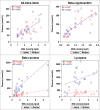Longitudinal Survey of Carotenoids in Human Milk from Urban Cohorts in China, Mexico, and the USA
- PMID: 26061885
- PMCID: PMC4465022
- DOI: 10.1371/journal.pone.0127729
Longitudinal Survey of Carotenoids in Human Milk from Urban Cohorts in China, Mexico, and the USA
Abstract
Emerging evidence indicates that carotenoids may have particular roles in infant nutrition and development, yet data on the profile and bioavailability of carotenoids from human milk remain sparse. Milk was longitudinally collected at 2, 4, 13, and 26 weeks postpartum from twenty mothers each in China, Mexico, and the USA in the Global Exploration of Human Milk Study (n = 60 donors, n = 240 samples). Maternal and neonatal plasma was analyzed for carotenoids from the USA cohort at 4 weeks postpartum. Carotenoids were analyzed by HPLC and total lipids by Creamatocrit. Across all countries and lactation stages, the top four carotenoids were lutein (median 114.4 nmol/L), β-carotene (49.4 nmol/L), β-cryptoxanthin (33.8 nmol/L), and lycopene (33.7 nmol/L). Non-provitamin A carotenoids (nmol/L) and total lipids (g/L) decreased (p<0.05) with increasing lactation stage, except the provitamin A carotenoids α- and β-cryptoxanthin and β-carotene did not significantly change (p>0.05) with lactation stage. Total carotenoid content and lutein content were greatest from China, yet lycopene was lowest from China (p<0.0001). Lutein, β-cryptoxanthin, and β-carotene, and lycopene concentrations in milk were significantly correlated to maternal plasma and neonatal plasma concentrations (p<0.05), with the exception that lycopene was not significantly associated between human milk and neonatal plasma (p>0.3). This enhanced understanding of neonatal exposure to carotenoids during development may help guide dietary recommendations and design of human milk mimetics.
Conflict of interest statement
Figures





References
-
- Barker FM 2nd, Snodderly DM, Johnson EJ, Schalch W, Koepcke W, Gerss J, et al. Nutritional manipulation of primate retinas, V: effects of lutein, zeaxanthin, and n-3 fatty acids on retinal sensitivity to blue-light-induced damage. Invest Ophthalmol Vis Sci. 2011;52(7):3934–42. Epub 2011/01/20. 10.1167/iovs.10-5898 - DOI - PMC - PubMed
Publication types
MeSH terms
Substances
LinkOut - more resources
Full Text Sources
Other Literature Sources
Medical

